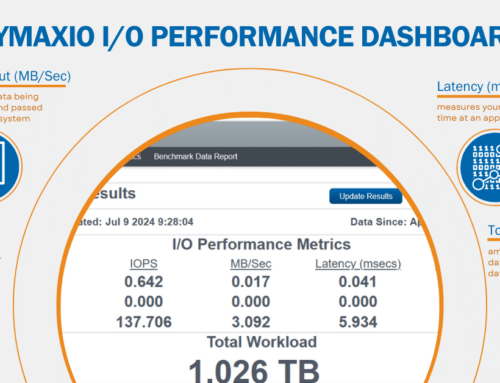Many people find themselves in the position of having to quickly increase the number of VDI instances on their existing infrastructure to support remote users. You may be asking yourself the question:
How can I do this without having to roll out a bunch of new hardware?
The answer is:
V-locity or new DymaxIO!
Let’s take a quick look at why this is true.
To start with let’s ask and answer the question:
What are the primary bottlenecks in VDI?
Since VDI operates on the premise that not every instance is active at any one point in time, VDI relies on the ability to over-allocate system resources such as CPU and memory. The same is generally thought to be acceptable with storage and network. However, the effect of lots of activity from multiple virtual machines (VDIs) being sent to resources, that are generally much slower than CPU and memory, guarantees that storage, and potentially your network, will become a serious bottleneck at critical times. This is generally referred to as the I/O Blender Effect.
There will be many times during the average workday where the underlying theory of inactivity holds true. However, there will be LOTS of times when a substantial number of desktops become active at or about the same time. Now by time, we are not talking about an hour or even just a 10-minute period of time. We are talking about intervals of milliseconds or at most a few seconds. Think of that exit ramp from the freeway. Most of the day there are just a couple of vehicles exiting so waiting for them isn’t a big deal. But what about during rush hour? What about when the 3 vehicles in front of you become 50 or 100 or more? If you’re anything like me the blood pressure rises and happy times are not upon you.
The reason that storage (and even the network) becomes the bottleneck, is that it takes a lot longer to handle the data requests that are sent to it. When it’s a handful of desktop instances, generally not a big deal. When it is dozens or hundreds, everyone waits and the users get frustrated with the delays. Now, you find yourself in the position where you need to increase the number of desktop instances significantly on that same set of resources. Do you really want to be getting those user complaints? Okay, I know your users are the nicest, kindest and most patient people in the world and are always understanding and never complain. You’re that lucky one in a million. Wake up and come back to the real world again – Do you really want to deal with the frustration?
The good news is we can help. Let’s take just a quick moment and shed a light onto how.
V-locity® and DymaxIO have 2 types of technologies that help mitigate the traffic jams to storage, and in many cases to the network:
- Elimination of Reads via extremely intelligent and patented caching technology
- Elimination of Read and Writes due to I/O Density improvements
Patented Caching Technology
Condusiv’s caching technology is called IntelliMemory®. The reason is that we intelligently use small amounts of memory to target noisy, performance-robbing, I/Os that no one else cares about. Applications can have their own specialized caches to make their data process faster. What most people never think about is all the I/Os from Windows and other background sources that have to be processed. These I/Os turn out to be a substantial part of the overall storage I/O stream, especially on desktops.
IntelliMemory was written from a different vantage point than other caching solutions. That was due, in no small part, to the fact that we wrote caching solutions for companies for 9 of the top 10 OEM PC manufacturers, like Western Digital, SanDisk, Samsung. We built an intelligent dynamic cache that could take limited memory resources and give the biggest bang for the buck in terms of I/O reductions. We give up memory when memory resources on the system become scarce and we use more when they become available. We understand that memory can be a scarce resource for the rest of the system, so we act as a good citizen balancing overall performance against memory resources. We also don’t allow a great resource to go unused when better performance can be had just for the asking.
IntelliMemory uses intelligent algorithms, based on empirical data collected in real-time, to maximize cache effectiveness versus resource availability. Put simply, we don’t waste memory on data that isn’t going to hit the cache. In fact, IntelliMemory targets the frequent I/Os that everyone else ignores. Yes, we will cache your normal data. But, we also cache all those noisy small I/Os that cause the biggest performance bottlenecks but that you don’t even know are happening, much less think about – those necessary Windows and other background process I/Os. And yes, those noisy I/Os generated by your desktop applications.
One interesting observation we have seen, when looking at data from desktop users, is that we eliminate a substantial percentage of the overall I/Os going to storage and often it is a smaller percentage of the overall data throughput than you might expect. The reason is all those I/Os that get in the way of your ability to process the data you need. It also turns out that they happen to be a perfect fit for our intelligent and dynamic cache. As a result, the storage system isn’t getting as backed up and you don‘t have to wait for that storage traffic jam.
I/O Density improvements
What about the elimination of reads and writes through density improvements? V-locity contains several technologies to assist in this process. They are optimized to use very little system resources to handle another bottleneck that causes extra I/Os to storage. This bottleneck is fragmentation. Because storage is managed by Windows dynamically, when you need more it gives you the most convenient chunks of free space on your volumes. As storage volumes have gotten larger and people have dramatically increased the amount of data they store on their systems, they are now experiencing an exponential increase in fragmentation. Here’s why this hurts you. Let’s say you try to write some data in 64KB chunks. If that data is allocated by the file system in 64KB chunks, then when you try to read it again or update it, you end up issuing a single I/O to get the data. Sounds good, right? Well, let’s say the file system allocates the data in 4KB chunks when you write it instead. Now when you read, or update, that data again, the file system has to send sixteen I/Os to the storage system, not one. You get the idea.
V-locity has a technology called IntelliWrite® that helps the Windows file system make sure that 64KB gets allocated as a single 64KB chunk instead of sixteen 4KB chunks. It does this by providing extra intelligence to the file system which makes the overhead of IntelliWrite virtually zero. V-locity also has a technology we refer to as Just In Time. What it does is collect real-time data about how files are accessed and when it notices specific files that are causing significant extra I/Os, because of how poorly they are laid out by the file system, it defragments just those. It also does it when you aren’t trying to deal with the storage traffic jam. In fact, we have algorithms, based on empirical data, that can tell there is a traffic jam being caused by other VMs than the one we are running on so we will avoid adding overhead at that time also. V-locity also contains a suite of engines that will handle other extreme causes of I/O bottlenecks such as cleaning up horrendous free space fragmentation that is the primary cause of file fragmentation and thus unnecessary storage I/O bottlenecks.
These are just a few customers who are improving VDI density just by installing V-locity:
“We added what equates to three times the workload with our new VDI implementation because of what V-locity is doing to reduce write I/O and read I/O at the VM layer. It’s been truly impressive. We call it the ‘V-locity effect.’” – Jamie Rabenstein, Information Technology Manager at Victor Community Support Services
“When you’re rolling out a VDI initiative, the one thing you can’t afford to waste is IOPS. With V-locity I/O reduction software running on our VDI instances, users no longer have to wait extra time.” – Joseph Navarrete, CIO at MFA
“V-locity has reduced I/O so dramatically, the IT team has been able to increase VM density while eliminating performance-related calls from the field.” – Shane Kolp, VP of Technology at KeystoneCare
We trust this has been a useful introduction for you into some of the reasons that make V-locity a great solution for increasing desktop instance density in a VDI environment.
Get started with NEW DymaxIO now for free
* Virtual desktop infrastructure (VDI) is a desktop virtualization technology wherein a desktop operating system, typically Microsoft Windows, runs and is managed in an on-premises or cloud data center.





Leave A Comment
You must be logged in to post a comment.